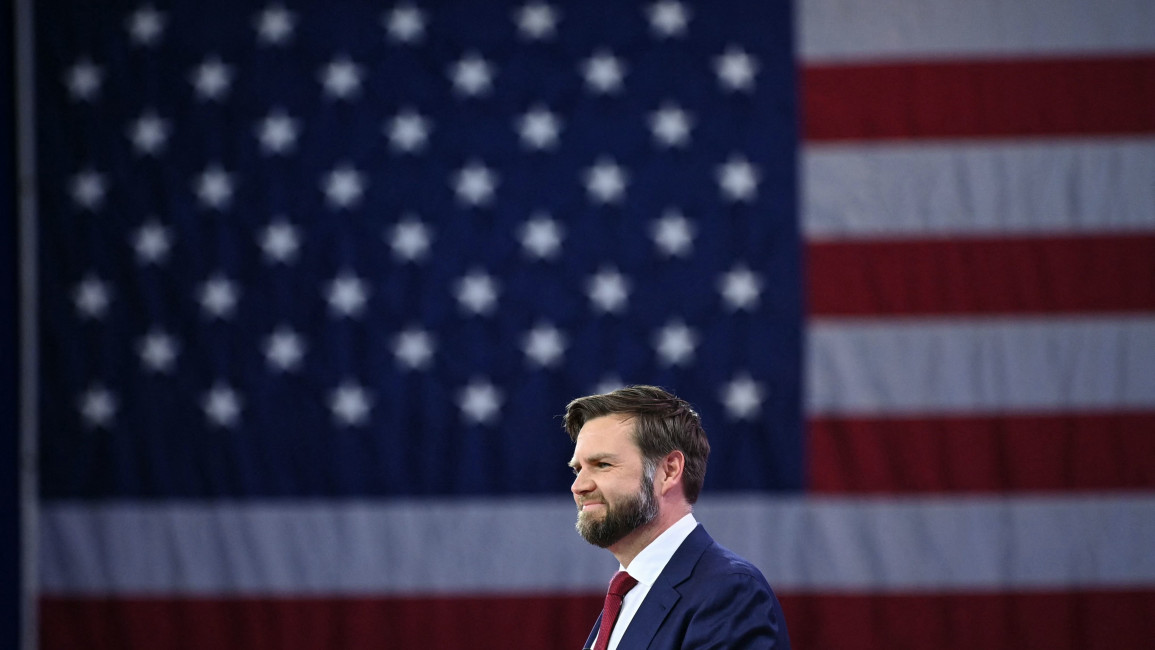
J.D. Vance and Donald Trump's red-pill plot to end US democracy
“Plots carry their own logic. There is a tendency of plots to move toward death… The tighter the plot of a story, the more likely it will come to death.” For Don DeLillo in Libra, his 1988 fictional account of the assassination of JFK, the events surrounding that day in Texas were a fait accompli from the moment the plotting began.
On Saturday, another assassination attempt was made, this time on President Donald Trump. Because this is a Trumpian world, the plot, if one existed, was thin and hard to follow; the gravity of the central figure warped everything, including the bullet trained for his head; and the death was moved to the periphery, a meaningless sacrifice for the MAGA machine.
As with all events since Trump’s first election, there was a certain collapse of meaning surrounding the attempt that likely only an early-career DeLillo could parse. Two things have emerged: Donald Trump has won the 2024 presidential election and his vice president will be marine turned venture capitalist turned Ohio senator, J.D. Vance.
Following the announcement of J.D. Vance as Trump’s number two, there was an outpouring of celebration from a certain faction of the liberal commentariat on Twitter that this was a “beatable ticket.” They pointed to his extreme positions on issues such as abortion, immigration, climate change, and the January 6 riot as evidence.
But this is a wilful delusion that demonstrates how little these people have learned since 2016 and their inability to grasp the fact that they are running a corpse. It also shows a critical lack of understanding of who J.D. Vance is and what position he holds in the new political landscape.
Demystifying J.D. Vance and the Neoreactionary Right
J.D. Vance is not a MAGA crackpot or a garden-variety Republican bending the knee to Trump; he represents a bridge between mainstream politics and the Neoreactionary Right, a political force that so far has remained largely on the periphery of electoral politics.
The New Right or Neoreactionary Right or Dissident Right is a broad coalition of disaffected former leftists, race scientists, auteur filmmakers, health gurus, podcasters, bodybuilder satirists, accelerationist fashion designers, Unabomber fans, and bitcoin maximalists. The discourse in neoreactionary circles is often so heavily meme-ified and laundered in irony that it can be difficult to know what they believe or even have in common.
However, in a Vanity Fair article covering the movement in 2022, which also happens to chart J.D. Vance’s ascent, James Pogue stated, “It is a project to overthrow the thrust of progress, at least such as liberals understand the word.”
At the centre of this project — or backing it from the shadows depending on who you ask — is tech billionaire Peter Thiel. Thiel has bankrolled a number of neoreactionary cultural projects, but he also has tried his hands at shaping politics. He was integral to J.D. Vance’s meteoric rise to the vice presidency. Vance was first hired by Thiel in 2017 to work at his investment firm, Mithril. He then went on to donate $15 million to J.D. Vance’s Senate campaign.
Much ink has been spilt trying to unpick the mystery of Thiel who, in contrast to the oafish public persona of his former Paypal Mafia partner Elon Musk, mostly avoids the limelight. Often these pieces focus on his investment portfolio over his esoteric writings or refer to a vague libertarian ideology, but this is a mistake.
For Thiel, 9/11 represented a fundamental break in the progression of the West and signalled the failure of the post-war project. Islam — there is little to no distinction between its various forms in his account — is an existential threat for Thiel, and he believes the West with its squeamishness of violence and questions of human nature is ill-equipped for what he sees as an inevitable clash of cultures.
"If the first Trump administration was marked by clownish incompetence — megalomania repeatedly thwarted by the buffoonery of “the best people” — J.D. Vance’s appointment signals the second term will be distinguished by a dark effectiveness"
In his essay The Straussian Moment, Thiel outlines the potential orgy of violence this clash could result in. He claims that to successfully combat Islam, the West would have to lose its identity. Elsewhere, Thiel has outlined what he sees as the three possible future dystopias for the West if it fails to put up a viable alternative vision: Sharia law, Chinese AI techno-surveillance, or a green energy dictatorship. He remains vague about his own alternative vision.
It was in the wake of 9/11 that Thiel, the supposed libertarian, founded Palantir, a data mining project that boasts the CIA, the FBI, the NSA, and the Marines as its clients. By 2009, Thiel was penning another essay in which he claimed he no longer felt “freedom and democracy are compatible,” and described possible escapes from politics into space or the ocean.
Around this time, Thiel began reading the works of another central neoreactionary figure, blogger Curtis Yarvin, whom Vance has also cited as a key influence. Yarvin is an ideas man for the movement. He is credited with coopting the term “red-pilled” from the Matrix series. Yarvin shares Thiel’s views on the inefficacy of modern liberal democracy, pointing to what he sees as the empty centre of power.
In Yarvin’s view, the American executive and legislature have been largely hollowed out, nobody is at the wheel, and the whole business of running the country depends on a system of bureaucratic and social processes that circle nothing.
Real power stems from what he calls the Cathedral: broadly, a group of prestige media organisations and elite academic institutions that dictate, through groupthink, what is acceptable discourse, largely favouring the interests of minorities and the liberal left.
Unlike Thiel, Yarvin has not been coy about setting out alternatives to the current system. Yarvin is a self-described monarchist, advocating for a reset of the American government and to establishment of a system of autocratic rule in its place.
The monarchy he prescribes is not necessarily the rule of divine right we might immediately associate with the word. Instead, Yarvin sets out a picture of authoritarian rule by a dictator akin to the role of a CEO from the world of venture capital. In other words, the world from which Thiel had initially placed J.D. Vance.
Trump’s antidemocratic tendencies are a function of his criminality. He is willing to push our institutions as far as is necessary to escape the noose. For Vance, as for the power brokers in the neoreactionary movement, the aversion to democracy is based on ideology. Another plot is working towards its conclusion, and within its sights is the American project.
As Paul Bradley Carr recently noted, Thiel’s first attempt at influencing the Trump administration failed because of Trump’s lack of interest in tech and Mike Pence’s Luddite tendencies. Now he has a man on the inside. In one of J.D. Vance’s first public appearances since being nominated as VP, he characterised the UK as the, “first truly Islamist country that will gain a nuclear weapon.”
If the first Trump administration was marked by clownish incompetence — megalomania repeatedly thwarted by the buffoonery of “the best people” — Vance’s appointment signals the second term will be distinguished by a dark effectiveness. J.D. Vance is smart. Peter Thiel is a genius. Many in the neoreactionary milieu are very smart. They have all identified a yawning void at the centre of American governance and are willing to tip the whole project towards collapse. How you feel about that depends on what you think they will build in place of the Cathedral.
Alex Foley is an educator and painter living in Brighton, UK. They have a research background in molecular biology of health and disease. They currently work on preserving fragile digital materials related to mass death atrocities in the MENA region.
Follow them on X: @foleywoley
Have questions or comments? Email us at: editorial-english@newarab.com
Opinions expressed in this article remain those of the author and do not necessarily represent those of The New Arab, its editorial board or staff.








